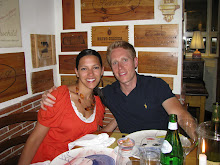I often think about my stint at La Locanda di Bu...It was this exact time of year in 2005, days after I'd rung in the new year back home in the States. Jetted off to Italy, right into my first "stage" in a town I had never heard of before, some damn place about sixty miles due east of Napoli. Little did I know that the hills of Irpinia, on which the little hamlet of Nusco is perched, are nothing like the sunny and palm tree replete scenery of the coast. To be fair it was winter when I arrived, and apparently the worst one in fifty years for Europe. It snowed pretty much every week of January and February, making it impossible for patrons to undertake the hike required to come from more populated places to the little forty seater Chef/Owner Antonio Pisaniello runs.
Being snowed in with nowhere to go more often than not, coupled with my work for food and board arrangement, not much else to do but be in the kitchen. It was tough to be so isolated, lacking the freedom of movement I am so used to back home, and I never got used to it. An overnight to Rome between storms seemed like an escape from prison. But the experience was a good one, mostly in hindsight; incredibly fruitful in learning about the kitchen, the principles of that area's cooking, and southern Italian culture. I realize now how fortunate I am to have done that in my lifetime, because it was a profound experience, something I'll never forget.
Toward the end of my Winter in Nusco, all of us from La Locanda went up to Rome, paid for by wine producer Mastroberardino, to cater a wine and dine event showcasing what Irpinia had to offer in those respects. We were set up at the Cittá del Gusto, which is a big event center run by Gambero Rosso, who, in Italy, is the equivalent of Zagat, Bon Appétit and Wine Spectator rolled into one.
The dish I am talking about here was our restaurant's primo course for the evening. It was an interesting concept because polenta is not historically a part of southern Italian food. But it was signature Locanda di Bu in the application of the ingredients, the simplicity but expert marriage of flavors and textures. Despite not requiring any serious technique, it does involve several steps and separate elements eventually brought together, but it is easily manageable.
'Tonino is a great chef; creative, ballsy and deeply connected to the land from which he derives his cuisine. What strikes me about his dishes is the paucity of ingredients he uses. When you get things like ridiculously fresh mozzarella and ricotta, animals raised by people you know personally and produce that's almost exclusively local, it makes so much sense. But we urbanites and suburbanites here have access to increasingly good products, so we can come close with the right amount of restraint and technique to create dishes that are almost as satisfying.
Chef and I had our differences, stemming primarily from my lack of credentials in the kitchen and my culture shock, but toward the end of the experience I was able to show him that I had absorbed a lot of what I was immersed in.
Notes on the recipe: I feel fairly certain that when we executed this dish in Rome the beans were completely pureed. That will yield something like the picture above, but you can partially puree or not puree anything, as the linked recipe suggests. Whatever you do with the beans, keep the escarole in whole form.
As for the polenta, in Italy we used and the recipe calls for the instant kind. I almost never use it, just because. Real polenta will take significantly longer than the five minute instant kind, but don't be fooled into the myth that it needs to be stirred incessantly like the rice in risotto. In fact, once you've whisked the cornmeal into the liquid and prevented lumps from forming, just leave it be on the lowest heat setting you can, adding and stirring a ladle of liquid in every ten minutes or so, and let it go. It can stay like that for an hour or three hours without any problems, in the background while you do other things. Just make some extra prosciutto broth the recipe calls for.




